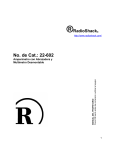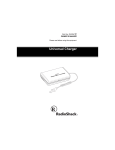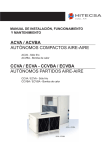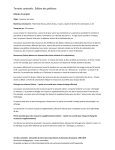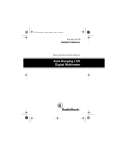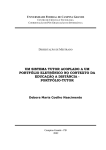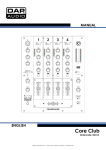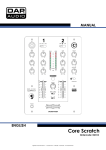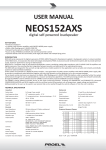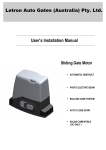Download Radio Shack Marine Instruments Marine Instruments User Manual
Transcript
Please read before using this equipment. Owner’s Manual Clamp-On AC Ammeter with Detachable Multimeter ˆ Contents Features ........................................................................................................... 3 A Word About Safety .................................................................................. 4 Special Panel Markings .................................................................................. 5 Specifications .................................................................................................. Ranges ....................................................................................................... Accuracy .................................................................................................... Miscellaneous ............................................................................................ 6 6 6 6 A Quick Look at Your Multimeter ................................................................... 7 Preparation ...................................................................................................... 8 Installing a Battery ...................................................................................... 8 Connecting the Test Leads ......................................................................... 9 Connecting the AC Ammeter to the Multimeter .......................................... 9 Zero Adjustment ....................................................................................... 10 Using the Multimeter ..................................................................................... Making Measurements ............................................................................. Measuring DC/AC Voltage ....................................................................... Measuring Three-Phase AC Voltage ................................................ Measuring AC Voltage Riding on a DC Source Bias ........................ Measuring Current ................................................................................... Measuring DC Current ...................................................................... Measuring AC Current in a Wire ....................................................... Measuring Wattage .................................................................................. Measuring Resistance .............................................................................. 10 10 11 12 13 13 13 14 16 16 Care ................................................................................................................ 17 Cleaning ................................................................................................... 17 Replacing the Fuse .................................................................................. 18 © 2001 RadioShack Corporation. All Rights Reserved. RadioShack and RadioShack.com are trademarks used by RadioShack Corporation. 2 Contents ˆ Features Your RadioShack Clamp-On AC Ammeter with Detachable Multimeter is designed with a precision meter movement to avoid mechanical shock damage. Your portable, compact multimeter is ideal for field, lab, shop, bench, and home applications. The multimeter measures DC and AC current, DC and AC voltage, and resistance. Important: • This multimeter is designed for indoor use only. • Completely read this manual before you use the multimeter. • If you are not familiar with multimeters and testing procedures, we suggest you read the book Using Your Meter (available at your local RadioShack store) before you use this multimeter. Here are some features that make your multimeter a real pro: Fuse and Diode Protection — help protect the multimeter. Battery Condition Testing — the multimeter shows when you need to replace the battery. Detachable Test Leads — let you store the multimeter neatly and connect the test leads only when you need to use the multimeter. Deluxe Carrying Case — protects your multimeter, ammeter, and test leads and lets you take them almost anywhere. Your multimeter has passed the critical safety tests required by Underwriters Laboratories for test equipment, meets UL 3111 Installation Category 1, Pollution Degree 2, and its 2000 ohm/volt sensitivity ensures accurate readings. Note: Your multimeter requires one AAA battery (not supplied). Detachable Clamp-On AC Ammeter — lets you measure AC current by simply clamping around a wire quickly and safely. Hold Function — lets you easily hold the displayed value when measuring AC current, so you can see the reading even after you disconnect the ammeter. Features 3 A WORD ABOUT SAFETY cover is in place and fully closed with the screw fully tightened. We have taken every precaution in designing this multimeter to ensure that it is as safe as we can make it. But safe operation depends on you, the operator. We recommend that you follow these simple safety rules: • Never apply voltages to the multimeter that exceed the limits given in “Specifications” on Page 6. Never apply more than 500V DC or 500V RMS AC between any input terminals or between an input terminal and ground. • Because many AC/DC sets have a potentially hot chassis, be sure the top of your workbench and the floor underneath it are made of non-conductive materials. This multimeter is fully calibrated and tested. Under normal use, no further adjustment should be necessary except as noted in this Owner’s Manual. If the multimeter requires repair, do not try to adjust it yourself. Take it to your local RadioShack store. WARNINGS: • Always discharge any capacitors of the circuit under test before you attach test leads. • USE EXTREME CAUTION IN THE USE OF THIS DEVICE. IMPROPER USE OF THIS DEVICE CAN RESULT IN INJURY OR DEATH. FOLLOW ALL SAFEGUARDS SUGGESTED IN THIS OWNER’S MANUAL IN ADDITION TO NORMAL SAFETY PRECAUTIONS IN DEALING WITH ELECTRICAL CIRCUITS. DO NOT USE THIS DEVICE IF YOU ARE UNFAMILIAR WITH ELECTRICAL CIRCUITS AND TESTING PROCEDURES. • Always turn off power and disconnect the test leads from the circuit you are testing before you replace the multimeter’s battery. • NEVER TRY TO PROBE WITH BOTH TEST LEADS AT THE SAME TIME OR HOLD BOTH TEST LEADS IN ONE HAND. • Never operate the multimeter unless its battery compartment • USE EXTREME CARE WHILE USING THE MULTIMETER TO • Use extreme caution when working with voltages above 40V. Always disconnect power from the circuit you are measuring before you connect test leads to high-voltage points. • Never connect the test leads to a source of voltage when the function selector is set to R×1KΩ, R×100Ω, 150mA DC mA, or ACA. 4 Features MEASURE CURRENT AND VOLTAGE IN COMMERCIAL ELECTRICAL PANELS. UNLIKE A HOME AC OUTLET, A COMMERCIAL ELECTRICAL PANEL HAS TREMENDOUS CURRENT SURGE POTENTIAL. THIS IS ESPECIALLY TRUE FOR THREE-PHASE INDUSTRIAL ELECTRICAL PANELS. A SMALL SPARK FROM ONE OF THESE PANELS CAN CAUSE A PLASMA EXPLOSION AND FIRE THAT CAN SEVERELY BURN YOU. DO NOT HOLD THE MULTIMETER WHILE USING IT. • ALWAYS WEAR PROTECTIVE LEATHER GLOVES, A FACE SHIELD, AND FIREPROOF ARM AND UPPER BODY PROTECTION WHILE USING THE MULTIMETER TO MEASURE CURRENT AND VOLTAGE IN COMMERCIAL ELECTRICAL PANELS. • IF THIS EQUIPMENT IS USED IN A MANNER NOT SPECIFIED BY THE MANUFACTURER, THE PROTECTION PROVIDED BY THE EQUIPMENT MAY BE IMPAIRED. • TO REDUCE THE RISK OF FIRE OR SHOCK HAZARD, DO NOT EXPOSE THIS PRODUCT TO RAIN OR MOISTURE. ˆ Special Panel Markings For your safety, we have added special markings to the multimeter’s panel to remind you of the measurement limitations. 500V MAX To avoid electrical shock or damage to the multimeter, do not connect the ground terminal (– jack) to any source that exceeds 500 volts with respect to earth/ground. 500V RMS MAX To avoid electrical shock or damage to the multimeter, do not connect the test leads to any source that exceeds 500 volts RMS AC. ! Caution: Risk of electric shock! Refer to the complete operating instructions. Caution: Be extra careful when making high-voltage measurements; DO NOT TOUCH TERMINALS OR PROBE ENDS. Special Panel Markings 5 ˆ Specifications RANGES AC/DC Voltage .......................................................................... 15V, 150V, 500V DC Current .............................................................................................. 150 mA AC Current ..................................................................................... 3A, 15A, 30A Resistance ...................................................................... 100kΩ (Center 3.5KΩ), 10KΩ (Center 350Ω) ACCURACY DC .......................................................................................... ±3.0% of full scale AC .......................................................................................... ±4.0% of full scale Resistance ................................................................... ±3.0% at full scale length Sensitivity, AC/DC Voltage ............................................................... 2000 Ω/Volt MISCELLANEOUS Operating Temperature ............................................... 32 to 109.4°F (0 to 43°C) Storage Temperature .................................................. –4 to 140°F (–20 to 60°C) Power Source ........................................................................... One AAA battery Dimensions (HWD) .......................................................... 77/8 × 25/8 × 11/8 Inches (200 × 66 × 28 mm) Weight ........................................................................................... 8.8 oz (250 g) Included Accessories .......................................................................... Test leads AC Ammeter Carrying Case Specifications are typical; individual units might vary. Specifications are subject to change and improvement without notice. 6 Specifications ˆ A Quick Look at Your Multimeter OHM S Ω OHMS ADJUST (left side of multimeter) AC AMMETER MULTIMETER A Quick Look at Your Multimeter 7 ˆ Preparation INSTALLING A BATTERY Top Cover Your multimeter requires one AAA battery (not supplied) for power. For the best performance and longest life, we recommend a RadioShack alkaline battery. Warnings: • To avoid electrical shock, disconnect both of the multimeter’s test leads from any equipment before you install or remove the multimeter’s battery. • Do not operate your multimeter until the battery is properly installed and the back cover is in place and secured. 3. Use a Phillips screwdriver to remove the screw on the lower back of the multimeter, then remove the multimeter’s back cover. Caution: Use only a fresh battery of the required size and recommended type. Follow these steps to install the battery. 1. Set the function selector to OFF to turn off the multimeter if it is on, then disconnect the test leads if they are connected. 2. Use a Phillips screwdriver to remove the screw on the upper back of the multimeter. Then pull up the top cover to remove it. 8 Preparation Back Cover 4. Place the battery in the compartment as indicated by the polarity symbols (+ and –) marked inside. 5. Replace the back cover and the top cover, then secure them with the screws. When you cannot adjust the needle to point to 0 on the scale when you measure resistance (see “Measuring Resistance” on Page 16) or the multimeter stops operating properly, replace the battery. Warning: Dispose of old batteries promptly and properly. Do not burn or bury them. Caution: If you do not plan to use the multimeter for a month or more, remove the battery. Batteries can leak chemicals that can destroy electronic parts. CONNECTING THE TEST LEADS The test leads supplied with your multimeter are rated for 1000 volts. Use only test leads of the same rating with the multimeter. You can order replacement leads from your local RadioShack store. Plug the black test lead’s right-angled end into the multimeter’s – (common) jack, then plug the red test lead’s right-angled end into the + jack. CONNECTING THE AC AMMETER TO THE MULTIMETER Cautions: • Always connect the ammeter to your multimeter before you clamp the ammeter to a wire carrying current. • Always unclamp the ammeter from a wire carrying current before you disconnect it from the multimeter. 1. Use a Phillips screwdriver to remove the screw on the upper back of the multimeter. Then pull up the top cover to remove it. 2. Insert the four pins on the ammeter as far as they will go into the top of the multimeter, then gently press the ammeter down onto the top of the multimeter until it clicks. WARNING: ALTHOUGH THE TEST LEADS ARE RATED FOR 1000 VOLTS, THE MAXIMUM RATING OF THIS MULTIMETER IS 500 VOLTS DC/500 VOLTS RMS AC. DO NOT TRY TO MEASURE ANY VOLTAGE GREATER THAN 500 VOLTS DC/ 500 VOLTS RMS AC. Preparation OH MS 9 3. Use the screw to secure the ammeter to the multimeter, then put the top cover you removed in Step 1 in a safe place. OHM S ZERO ADJUSTMENT If the needle does not normally rest exactly over 0 on the left side of the ACVA/DCVA scale, use a flat screwdriver to adjust the plastic screw on the center of the multimeter’s face to set the needle to 0. ˆ Using the Multimeter WARNING: DO NOT TRY TO MEASURE ANY VOLTAGE GREATER THAN 500 VOLTS DC/500 VOLTS RMS AC. Caution: When the multimeter is not in use, always leave the function selector set to OFF. To use the multimeter, use the function selector to switch between the multimeter’s functions. Then connect the test leads to the circuit you want to measure. MAKING MEASUREMENTS For the most accurate readings, the temperature should be between 43°F and 74°F (6°C and 23°C), with a maximum of 80% relative humidity. Keep the multimeter lying flat on a non-metallic surface. Also, use a range setting that results in a reading in the upper third of the multimeter’s scale. For exact readings, look at the scale from an angle where the needle and its reflection in the mirror come together. Caution: Be sure to select the correct function before you touch the test leads to the circuit or component to be tested. 10 Using the Multimeter MEASURING DC/AC VOLTAGE WARNINGS: • NEVER CLAMP A TEST LEAD TO A HOT WIRE (USUALLY RED, BLACK, OR BLUE IN AC WIRING CIRCUITS). IF ONE LEAD IS CLAMPED TO A HOT WIRE AND YOU TOUCH THE MULTIMETER’S OTHER PROBE, YOU COULD RECEIVE AN ELECTRIC SHOCK. • THE MAXIMUM INPUT LIMIT FOR VOLTAGE MEASUREMENT IS 500V DC OR 500V AC (RMS). TO AVOID ELECTRICAL SHOCK AND DAMAGE TO THE MULTIMETER, NEVER TRY TO MEASURE DC VOLTAGE ABOVE 500 VOLTS OR AC VOLTAGE ABOVE 500 VOLTS RMS. • TO AVOID ELECTRICAL SHOCK AND DAMAGE TO THE MULTIMETER, NEVER CONNECT THE TEST PROBE PLUGGED INTO THE – JACK TO A SOURCE OF VOLTAGE ABOVE 500 VOLTS. Follow these steps to measure AC or DC voltage. 1. Set the function selector to one of the DCV positions (to measure DC voltage) or to one of the ACV positions (to measure AC voltage). Note: If you are not sure about the voltage level you are measuring, set the function selector to 500 DCV or 500 ACV. Then keep trying the next lowest range as necessary until the reading appears in the upper third of the multimeter’s scale. 2. Touch the test leads to the circuit you want to test. • If the function selector is set to 500 ACV or 500 DCV, read the upper line of ACVA/DCVA on the multimeter. The AC or DC voltage is the reading you see. For example, if the needle points to 200, the AC or DC voltage is 200 volts. Otherwise, read the lower line of ACVA/DCVA on the multimeter then multiply the reading you see by 500/3. For example, if the needle points to 2.4, the AC or DC voltage is 400 volts (2.4 × 500/3 = 400V). • If the function selector is set to 150 ACV or 150 DCV, read the lower line of ACVA/DCVA on the multimeter then multiply the reading you see by 50. For example, if the needle points Using the Multimeter 11 to 2, the AC or DC voltage is 100 volts (2 × 50 = 100V). YOU DO NOT USE THIS MULTIMETER FOR SUCH APPLICATIONS. • If the function selector is set to 15 DCV, read the lower line of ACVA/DCVA on the multimeter then multiply the reading you see by 5. For example, if the needle points to 2, the DC voltage is 10 volts (2 × 5 = 10V). We designed this multimeter primarily to measure household AC voltages. If you want to measure 3-phase, line-toline voltages, please note that the actual voltage can be greater than the circuit’s rated line-to-ground voltage. • If the function selector is set to 15 ACV, read the AC15V line on the multimeter. For example, if the needle points to 10, the AC voltage is 10 volts. Hint: When you use the multimeter to probe for a voltage in a high-voltage circuit, we recommend you do not try to position both test leads at once. Instead, use an insulated alligator clip (not supplied) to clamp one test lead to the circuit's neutral or ground lead (usually a bare, green, or white lead in AC wiring circuits). Then place your free hand in your pocket or behind your back and probe for voltages with the other test lead. This helps prevent you from accidentally touching a hot wire, since you need only concentrate on one test lead. Measuring Three-Phase AC Voltage WARNING: BECAUSE OF THE DANGERS INHERENT IN MEASURING THREE-PHASE CIRCUITS, WE STRONGLY RECOMMEND THAT 12 Most 3-phase power circuits are rated by their line-to-line voltage. This voltage is higher than the line (or phase) to ground voltage. To determine if a line-to-line 3-phase voltage exceeds the rating of this multimeter, multiply the rated line-to-ground voltage by 1.732 (the square root of 3). For example, if the rated line-to-ground voltage is 300 volts, the line-to-line voltage is 300 × 1.732 = 519.6 V AC. Warning: This voltage exceeds the multimeter’s rating. Therefore, you should not connect the multimeter to this circuit or to any equipment connected to the circuit. Doing so could present a dangerous shock hazard to you, and could also damage the multimeter. If you do not know why there is a voltage difference, you should not be working on three-phase power circuits. These circuits are generally extremely powerful and very dangerous. Special safety equipment should be worn when working around these dangerous circuits. Using the Multimeter Measuring AC Voltage Riding on a DC Source Bias 2. Disconnect the test leads from the circuit. To measure AC voltage superimposed on a DC voltage source bias while ignoring the DC voltage, you must first measure the AC and DC voltages separately, then compute the peak voltage using this formula: 3. Remove power from the circuit under test and discharge all capacitors. Peak voltage = DC voltage + AC voltage/0.707 WARNINGS: • TO AVOID INJURY OR DAMAGE TO YOUR MULTIMETER, NEVER TRY TO MEASURE AN AC VOLTAGE THAT IS RIDING ON A DC SOURCE BIAS WHERE THE PEAK VOLTAGE EX-CEEDS 100V WITH RESPECT TO EARTH GROUND. • TO AVOID INJURY OR DAMAGE TO YOUR MULTIMETER, NEVER TRY TO MEASURE ANY VOLTAGE MORE THAN 30V AC ON A DC SOURCE BIAS. Follow these steps to measure an AC voltage superimposed on a DC voltage source bias. 1. Set the function selector to one of the DCV positions. Then touch the test leads to the circuit you want to test and note the reading on the upper or lower line of ACVA/DCVA on the multimeter. 4. Set the function selector to one of the ACV positions. Then connect a 0.1 microfarad/100V polyester film capacitor in series with the positive terminal of the voltage source and the red test lead. 5. Connect the – (common) test lead to ground and note the reading on the upper or lower line of ACVA/DCVA on the multimeter. The multimeter shows the AC voltage. Warning: To avoid electric shock, never touch the circuit and test terminals while testing. 6. When you finish measuring the AC voltage, disconnect the power from the circuit under test then disconnect the capacitor you connected in Step 4. MEASURING CURRENT Measuring DC Current WARNING: DO NOT APPLY VOLTAGE TO THE TEST LEADS WHILE THE FUNCTION SELECTOR IS SET TO 150mA DC mA. THE CONNECTION MUST BE IN SERIES WITH THE CURRENT. Using the Multimeter 13 1. Set the function selector to 150 mA DC mA. 2. Remove power from the circuit under test and discharge all capacitors. 3. Break the electrical path for the circuit in which you want to measure current. Then connect the – (common) test lead to the negative side and the positive (+) test lead to the positive side of the circuit. OH MS 4. Apply power to the circuit. 5. Read the lower line of ACVA/ DCVA on the multimeter, then multiply that reading by 50 to compute the current. For example, if the needle points to 2, the DC current is 2 × 50 = 100mA. If the needle points to 1, the DC current is 1 × 50 = 50mA. Measuring AC Current in a Wire WARNING: DO NOT APPLY VOLTAGE TO THE TEST LEADS WHILE THE FUNCTION SELECTOR IS SET TO ACA. Important: Make sure you place only one wire inside the ammeter's jaws at a time. If you try to measure AC current in more than one wire at a time, such as an AC power cord of a household appliance, the measurement will not be accurate. 14 1. Connect the ammeter to the multimeter (see “Connecting the AC Ammeter to the Multimeter” on Page 9). 2. Set the function selector to ACA. 3. Test the ammeter by sliding T/3A/ 15A/30A on the ammeter to T, then reading the line below AC15V on the multimeter. If the needle points to GOOD on the multimeter, the ammeter is working. Skip to Step 4. If the needle points to FAIL on the multimeter, check the multimeter’s battery (see “Installing a Battery” on Page 8), then repeat Step 3. If the needle points to FAIL again, take the multimeter to your local RadioShack store. Using the Multimeter 4. Hold down the trigger lever on the ammeter. The ammeter’s jaws open. Then insert the wire you are measuring inside the probe's jaws and release the trigger lever. 6. To help ensure an accurate reading, move the probe so the wire is in the center of the open area inside the jaws. 7. Read the lower line of ACVA/ DCVA on the multimeter. • If T/3A/15A/30A on the ammeter is set to 3A, the AC current is the reading you see. For example, if the needle points to 2, the AC current is 2 amps. OH • If T/3A/15A/30A on the ammeter is set to 15A, multiply that reading by 5 to compute the current. For example, if the needle points to 2, the AC current is 10 amps (2 × 5 = 10A). MS 5. Slide T/3A/15A/30A on the ammeter to 3A, 15A, or 30A (to measure current). Note: If you are not sure about the current level you are measuring, slide T/3A/15A/30A on the ammeter to 30A. Then keep trying the next lowest range as necessary until the reading appears on the lower line of ACVA/DCVA on the multimeter. • If T/3A/15A/30A on the ammeter is set to 30A, multiply that reading by 10 to compute the current. For example, if the needle points to 2, the AC current is 20 amps (2 × 10 = 20A). 8. Press HOLD on the ammeter to hold the reading you see. HOLD clicks and stays in. Press HOLD again to release hold. HOLD clicks and pops out. 9. When you finish measuring current, set the function selector to OFF. Then remove the AC ammeter from the multimeter and secure the top cover and back cover with the screws. Using the Multimeter 15 MEASURING WATTAGE You can use the multimeter and ammeter to tell how many watts of power an appliance uses. This helps you determine what the electricity costs are for that appliance. The following formula can help you make the necessary conversion. V (volts) × A (amps) = W (watts) To determine how many watts an appliance uses, use your multimeter to measure the number of volts it uses (120 volts single-phase AC is standard for most household appliances) then connect the ammeter to the multimeter and use both to measure the current it uses. Then multiply those numbers. For example, if your air conditioner uses 120 volts and you measured 10 amps, it uses 1,200 watts. MEASURING RESISTANCE The resistance measuring circuit in your multimeter compares the voltage gained through a known resistance (internal) with the voltage developed across an unknown resistance. WARNING: BE SURE THE CIRCUIT UNDER TEST HAS ALL POWER REMOVED AND ANY ASSOCIATED CAPACITORS ARE FULLY DISCHARGED BEFORE YOU MAKE A RESISTANCE MEASUREMENT. 16 Caution: Never connect the test leads to a source of voltage when the function selector is set to R×1KΩ or R×100Ω. Note: When you measure the resistance of a component in a circuit, disconnect one side of the component you are testing. This prevents other components in the circuit from interfering with the reading. Follow these steps to measure resistance. 1. Set the function selector to R×1KΩ or R×100Ω. 2. Touch the test leads together, then rotate OHMS ADJUST on the side of the multimeter until the needle points to 0 on the top line on the multimeter. 3. Touch the test leads across the circuit you want to measure, or remove one of the leads of the component you want to measure from its circuit and touch the test leads across the component. Then read the top OHMS line on the multimeter. • If the function selector is set to R×100Ω, multiply that reading by 100 to compute the resistance. For example, if the needle points to 1, the resistance is 100 ohms (1 × 100 = 100Ω). Using the Multimeter Hint: If you are identifying cathode and anode ends or the type of transistor (PNP or NPN), the actual polarity of the multimeter's voltage is the opposite of the polarity suggested by the test probes' color. The red test probe is the negative source, and the black test probe is the positive source. • If the function selector is set to R×1KΩ, multiply that reading by 1000 to compute the resistance. For example, if the needle points to 1, the resistance is 1000 ohms (1 × 1000 = 1000Ω). ˆ Care CLEANING Keep the multimeter dry; if it gets wet, wipe it dry immediately. Use and store the multimeter only in normal temperature environments. Handle the multimeter carefully; do not drop it. Keep the multimeter away from dust and dirt. To keep the multimeter looking new, occasionally wipe it with a cloth slightly dampened with water. Do not use harsh chemicals, cleaning solvents, or strong detergents to clean the multimeter. Modifying or tampering with the multimeter’s internal components can cause a malfunction and might invalidate its warranty. If your multimeter is not performing as it should, take it to your local RadioShack store for assistance. WARNINGS: • DO NOT LET ANY WATER DRIP INSIDE THE MULTIMETER WHILE CLEANING IT. • MAKE SURE THAT THE MULTIMETER IS COMPLETELY DRY BEFORE USING IT. Care 17 REPLACING THE FUSE 6. If the fuse is blown, discard it and save the ribbon (to use with the next spare fuse you store in the compartment). Then remove the spare fuse and the ribbon holding it from the upper back of the multimeter and insert it into the fuse holder. If the multimeter does not work, you might need to replace the fuse with the supplied 315 mA, 250V ceramic fuse. The spare fuse is next to the battery compartment. Caution: Do not use a fuse with ratings other than those specified here. Doing so might damage your multimeter. 7. Replace the battery in the compartment. Warning: Do not operate your multimeter until the back cover and top cover are in place and secured. Follow these steps to replace the fuse. 1. Set the function selector to OFF, then disconnect the test leads if they are connected. 8. Replace the back cover and the top cover, then secure them with the screws. WARNING: TO AVOID ELECTRIC SHOCK, YOU MUST DISCONNECT THE TEST LEADS BEFORE YOU REMOVE THE BACK COVER. 2. Use a Phillips screwdriver to remove the screw on the upper back of the multimeter. Then remove the top cover. 3. Use a Phillips screwdriver to remove the screw on the lower back of the multimeter, then remove the multimeter’s back cover. 4. Remove the battery. 5. To remove the fuse, gently pull the red ribbon holding it. The fuse pops out. 18 Care ˆ Notes Notes 19 Limited Ninety-Day Warranty This product is warranted by RadioShack against manufacturing defects in material and workmanship under normal use for ninety (90) days from the date of purchase from RadioShack company-owned stores and authorized RadioShack franchisees and dealers. EXCEPT AS PROVIDED HEREIN, RadioShack MAKES NO EXPRESS WARRANTIES AND ANY IMPLIED WARRANTIES, INCLUDING THOSE OF MERCHANTABILITY AND FITNESS FOR A PARTICULAR PURPOSE, ARE LIMITED IN DURATION TO THE DURATION OF THE WRITTEN LIMITED WARRANTIES CONTAINED HEREIN. EXCEPT AS PROVIDED HEREIN, RadioShack SHALL HAVE NO LIABILITY OR RESPONSIBILITY TO CUSTOMER OR ANY OTHER PERSON OR ENTITY WITH RESPECT TO ANY LIABILITY, LOSS OR DAMAGE CAUSED DIRECTLY OR INDIRECTLY BY USE OR PERFORMANCE OF THE PRODUCT OR ARISING OUT OF ANY BREACH OF THIS WARRANTY, INCLUDING, BUT NOT LIMITED TO, ANY DAMAGES RESULTING FROM INCONVENIENCE, LOSS OF TIME, DATA, PROPERTY, REVENUE, OR PROFIT OR ANY INDIRECT, SPECIAL, INCIDENTAL, OR CONSEQUENTIAL DAMAGES, EVEN IF RadioShack HAS BEEN ADVISED OF THE POSSIBILITY OF SUCH DAMAGES. Some states do not allow limitations on how long an implied warranty lasts or the exclusion or limitation of incidental or consequential damages, so the above limitations or exclusions may not apply to you. In the event of a product defect during the warranty period, take the product and the RadioShack sales receipt as proof of purchase date to any RadioShack store. RadioShack will, at its option, unless otherwise provided by law: (a) correct the defect by product repair without charge for parts and labor; (b) replace the product with one of the same or similar design; or (c) refund the purchase price. All replaced parts and products, and products on which a refund is made, become the property of RadioShack. New or reconditioned parts and products may be used in the performance of warranty service. Repaired or replaced parts and products are warranted for the remainder of the original warranty period. You will be charged for repair or replacement of the product made after the expiration of the warranty period. This warranty does not cover: (a) damage or failure caused by or attributable to acts of God, abuse, accident, misuse, improper or abnormal usage, failure to follow instructions, improper installation or maintenance, alteration, lightning or other incidence of excess voltage or current; (b) any repairs other than those provided by a RadioShack Authorized Service Facility; (c) consumables such as fuses or batteries; (d) cosmetic damage; (e) transportation, shipping or insurance costs; or (f) costs of product removal, installation, set-up service adjustment or reinstallation. This warranty gives you specific legal rights, and you may also have other rights which vary from state to state. RadioShack Customer Relations, 200 Taylor Street, 6th Floor, Fort Worth, TX 76102 We Service What We Sell RadioShack Corporation Fort Worth, Texas 76102 12/99 22-602 01A01 Printed in China




















